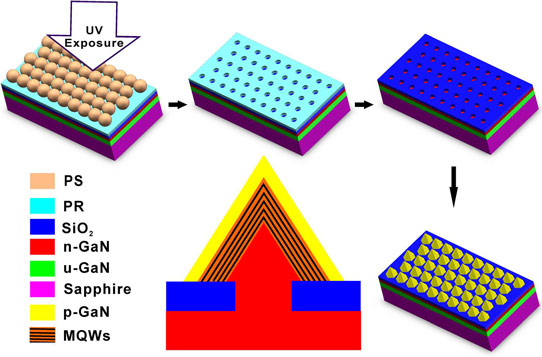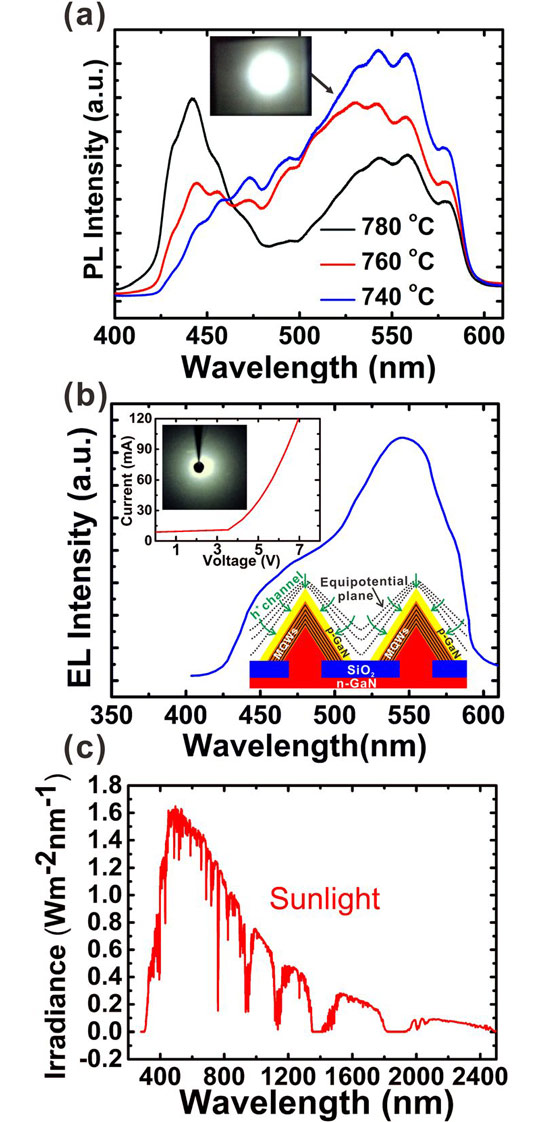- News
30 December 2013
White light-emitting diodes from selective epitaxy GaN nanopyramids
Researchers in China have developed a selective area epitaxy (SAE) approach to create nanopyramids of nitride semiconductor ‘white’ light-emitting diodes (LEDs) without using phosphors [Kui Wu et al, Appl. Phys. Lett., vol103, p241107, 2013]. The research involved various Chinese Academy of Sciences institutes – Institute of Semiconductors, Institute of Mechanics, and Suzhou Institute of Nano-tech and Nano-bionics – and Tsinghua University.
The prospect of using nanopyramids for white light emission was raised earlier this year by Taiwan researchers who produced green, olivine and amber LEDs. See Exploring nanopyramid approach to longer-wavelength nitride LEDs
The template for the Chinese nanopyramids was a 2μm n-GaN layer on c-plane sapphire, produced through metal-organic chemical vapor deposition (MOCVD). The GaN surface was then covered with 400nm silicon dioxide that was patterned with holes in a hexagonal array created by ultraviolet nanospherical-lens photolithography (NLP) through a mask consisting of close-packed polystyrene nanospheres (Figure 1).

Figure 1: Schematic illustrations of the process for fabricating phosphor-free nanopyramid white GaN LEDs by NLP method.
The template was then returned to the MOCVD equipment for SAE growth of n-GaN nanopyramids and then a 2nm indium gallium nitride (InGaN) well and 18nm GaN barrier as strain compensation. The active region consisted of a five-period InGaN/GaN (3nm/8nm) multiple quantum well/barrier structure. The p-type contact regions consisted of a 20nm aluminium gallium nitride (Al0.15Ga0.85N) electron-blocking layer and 30nm of GaN cladding.
The nanopyramids consist of six-sided structures on a hexagonal base with side-walls in the {10-11} crystal orientation. One effect of SAE is the blocking of dislocations threading from the template into the nanopyramids. By creating structures free of threading dislocations, one source of current leakage is avoided. The {10-11} orientation is semi-polar, meaning the strain-dependent and spontaneous electric fields arising from the polarization of the various III-nitrogen bonds are reduced. The reduced fields lead to a decrease in the quantum-confined Stark effect (QCSE), where the electrons and holes are impeded from recombining into photons. These QCSEs become more severe for longer-wavelength emissions such as green and yellow from InGaN wells.
Photoluminescence (PL) from the nanopyramids showed a wide-band response in the wavelength range 400–600nm (Figure 2). The growth temperature of the strain compensation and active regions affects the peak of the spectral response. The higher temperature of 780°C gave a material with a peak around 450nm (with a secondary broader peak at ~550nm).

Figure 2: (a) Room-temperature PL spectra from MQWs of nanopyramid LEDs grown at different temperatures; inset shows optical microscope image taken from PL measurement. (b) EL emission spectra of LEDs at a 20mA current. Inset shows the current–voltage (I-V) characteristic and schematic diagram of current distribution of nanopyramid LEDs. (c) Sunlight spectrum (data from www.nrel.gov/rredc/solar_data.html).
With 740°C growth, the short-wavelength peak disappeared, leaving a broad peak around 550nm. The 500nm wavelength corresponds to yellow emission, the light to which the human eye is most sensitive. The 740°C nanopyramids also give a ‘white’ light electroluminescence (EL) under 20mA injection current. The turn-on voltage is about 3V.
The broadband radiation is due to variations in indium incorporation and well thickness from the base to apex of the nanopyramids. By firing an electron beam and observing a nanopyramid’s response, one finds that radiation from the base tends to have high yellow content while that from the apex is blue. Blue-green emissions come from the middle region of the facets.
Exploring nanopyramid approach to longer-wavelength nitride LEDs
White LEDs GaN nanopyramids GaN MOCVD NLP
http://dx.doi.org/10.1063/1.4840137
The author Mike Cooke is a freelance technology journalist who has worked in the semiconductor and advanced technology sectors since 1997.


